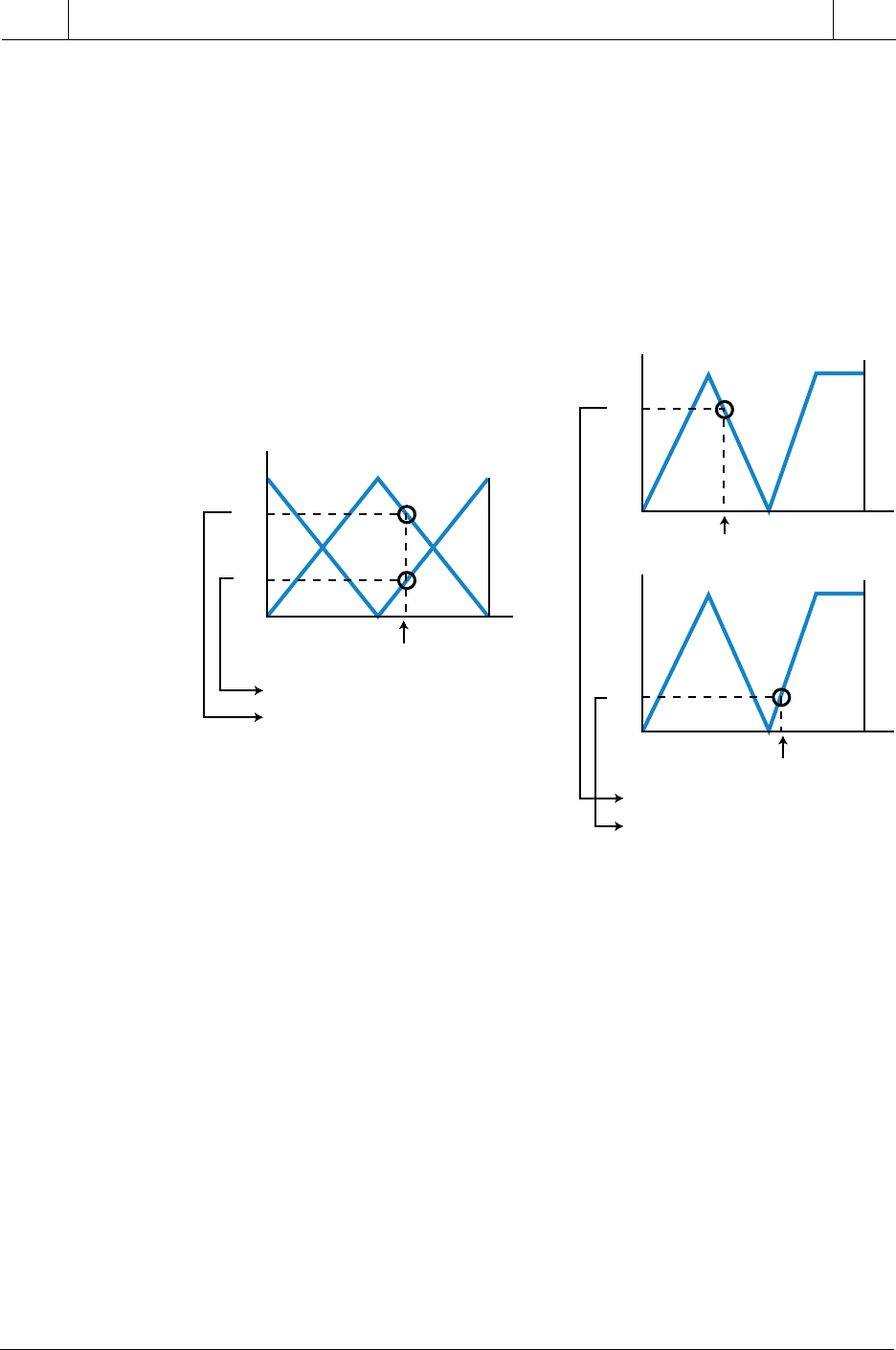Bryan L. Programmable controllers. Theory and implementation
Подождите немного. Документ загружается.


839
CHAPTER
17
Fuzzy
Logic
SECTION
5
Advanced PLC
Topics and Networks
Industrial Text & Video Company 1-800-752-8398
www.industrialtext.com
FUZZY INFERENCE ENGINE
The selection of the fuzzy inference engine encompasses the determination
of how the fuzzification process will take place (e.g., the number and form
of membership function, etc.), how the rules determine an outcome, and
how the fuzzy controller implements the defuzzification.
Fuzzification. The fuzzification process, which utilizes the membership
functions defined by the user, assigns a grade to each fuzzy input received.
This grade determines the level of outcome that will be triggered. Therefore,
the shape of the fuzzy set’s membership functions is important, since the
shape determines the input signals’ grades, which are mapped on the output
membership function.
Some fuzzy controllers allow the user to choose the shape of the membership
functions by trial and error, while others have predefined membership
function shapes. When using trial and error to determine the function shapes
in a closed-loop fuzzy control system, the input membership functions
should begin with overlapped Λ-shaped labels (see Figure 17-58). This
ensures smoother control for the first trial due to the coverage provided by
the Λ shape and the overlapping at the minimum and maximum points,
which creates a balance (i.e., when one label grade is 1, the other is 0). The
number of labels, or membership functions, that will form the fuzzy set is also
an important part of the system design. For example, if a fuzzy set has five
0 counts 4095 counts
1
0
Grade
NSNL ZR PS PL
Input Data
0 counts 4095 counts
1
0
Grade
NL ZR PL
Input Data
Figure 17-58. Fuzzy input sets using (a) five and (b) three membership functions.

840
SECTION
5
Advanced PLC
Topics and Networks
Industrial Text & Video Company 1-800-752-8398
www.industrialtext.com
CHAPTER
17
Fuzzy
Logic
labels covering the same input data range as a three-label fuzzy set (refer to
Figure 17-58), the one with five labels will provide more fine-tuned control,
especially if the output membership function also has five labels.
Although membership functions do not have to be symmetrical (see Figure
17-59), asymmetrical fuzzy sets should be carefully designed to ensure that
they describe the fuzzy variable input properly. In Figure 17-59, the inner
membership functions provide more sensitivity near the zero label (from NS
to PS) than at the NL and PL labels (from NL to NS and from PS to PL).
Asymmetrical membership functions are typically used in open-loop system
applications.
0 counts 4095 counts
1
0
Grade
NSNL ZR PS PL
Input Data
More
Sensitive
Less
Sensitive
Less
Sensitive
Figure 17-59. Asymmetrical fuzzy input set.
Sometimes, a membership function in a fuzzy set may not provide any
sensitivity between two labels. As illustrated in Figure 17-60, the flat
sections of the membership functions do not influence neighboring functions
or the output. Therefore, the output will not change if the input variable falls
in these regions.
Figure 17-60. Fuzzy input set with no sensitivity at the flat sections between the labels.
Grade
1
0
Input Data
No influence from one
membership function to
another at these points
If the input changes from here
to here,
the grade will not be altered.

841
CHAPTER
17
Fuzzy
Logic
SECTION
5
Advanced PLC
Topics and Networks
Industrial Text & Video Company 1-800-752-8398
www.industrialtext.com
Rule Decision Making and Outcome Determination. The easiest way to
formulate the rules for a fuzzy logic controller is to first write them as
IF…THEN statements that describe how the inputs affect the outcome. Some
fuzzy controllers are capable of handling two outputs at the same time, thus
allowing two rules to be combined. For example, the rules:
IF A = PS AND B = NS THEN C = ZR
IF A = PS AND B = NS THEN D = NS
can be combined into one rule:
IF A = PS AND B = NS THEN C = ZR and D = NS
This rule gives two outcomes, thus invoking two defuzzification processes,
one for each controlling output. It is easiest, however, to create each rule
individually (with only one outcome) and then combine them later. If at any
point during the rule definition you are uncertain of the operational knowl-
edge required for that particular rule, you should consult a knowledgeable
operator so that he/she can provide you with more input information.
As mentioned earlier, you may or may not have a choice of output member-
ship function shapes (Λ, Π, S, or Z). You also may or may not have a choice
about whether the functions are continuous or discrete (see Figure 17-61).
Figure 17-61. Fuzzy output sets with (a) continuous and (b) noncontinuous membership
functions.
0 counts 4095 counts
1
0
Grade
NSNL ZR PS PL
Output Data
0 counts 4095 counts
1
0
Grade
NSNL ZR PS PL
Output Data
(a)
(b)

842
SECTION
5
Advanced PLC
Topics and Networks
Industrial Text & Video Company 1-800-752-8398
www.industrialtext.com
CHAPTER
17
Fuzzy
Logic
Remember that, before defuzzification occurs, the fuzzy controller adds all
the outcomes based on the appropriate logic. If the rule contains a logical
AND function, the controller will select the lowest output value; if the rule
contains an OR function, the controller will select the highest output value.
If an application requires a highly accurate or smooth output, the rules
should be designed so that an input condition triggers two or more rules. To
do this, either the input membership functions must overlap or two input
conditions must influence the same output (see Figure 17-62).
Figure 17-62. Two rules triggered by (a) one input in an overlapping membership function
and (b) two inputs in two nonoverlapping membership functions.
Defuzzification. During the design of a fuzzy logic system, you may be
required to choose a defuzzification method, especially if the output member-
ship function is noncontinuous. Defuzzification methods include the center
of gravity (centroid), the left-most maximum, and the right-most maximum
(see Figure 17-63). If the selected defuzzification method is the center of
gravity approach, the triggering rules must be arranged so that at least one
rule is triggered at all times. Thus, there must always be an output from a rule.
The controller will generate an error if there is no output due to a gap in input
condition coverage.
Figure 17-64 illustrates two fuzzy input sets with four rules, which have a
potential error condition due to improper coverage of the inputs by the rules
defined. For instance, if the X
1
input intersects label ZR at the point where
only ZR, and not PL, is triggered (shown as the gap in Figure 17-64a) and
0 counts 4095 counts
1
0.6
0.4
0
Grade
NL ZR PL
Input
X
IF
X
= PL THEN Output
Y
= ZR
IF
X
= ZR THEN Output
Y
= NL
1
0.6
0
Grade
ZR PL
Input
X
1
1
0.3
0
Grade
NL ZR
Input
X
2
IF
X
1
= ZR THEN Output
Y
= PL
IF
X
2
= ZR THEN Output
Y
= NS
(a)
(b)

843
CHAPTER
17
Fuzzy
Logic
SECTION
5
Advanced PLC
Topics and Networks
Industrial Text & Video Company 1-800-752-8398
www.industrialtext.com
Figure 17-63. (a) Seven outputs with the final output selected using (b) the left-most max-
imum, (c) the right-most maximum, and (d) the center of gravity methods.
5850 1170 1755 2340 2925 3510 4095
1
0.8
0.7
0.5
0.4
0
Grade
NSNL NM ZR PS PM PL
Output
Data
5850 1170 1755 2340 2925 3510 4095
1
0.8
0
Grade
NM
Output
Data
5850 1170 1755 2340 2925 3510 4095
1
0.8
0
Grade
NSNL NM ZR PS PM PL
Output
Data
5850 1170 1755 2340 2925 3510 4095
1
0.8
0.7
0.5
0.4
0
Grade
NSNL NM ZR PS PM PL
Output
Data
Selected output
is 1170 counts
(left-most maximum)
Selected output
is 3510 counts
(right-most maximum)
Selected output is 1852 counts
(center of gravity)
(a)
(b)
(c)
(d)

844
SECTION
5
Advanced PLC
Topics and Networks
Industrial Text & Video Company 1-800-752-8398
www.industrialtext.com
CHAPTER
17
Fuzzy
Logic
Figure 17-65. A gap in a fuzzy input set.
Figure 17-64. Improper coverage of inputs leading to an error condition.
input X
2
intersects label ZR anywhere in the gap area shown in Figure 17-
64b, no rule will be triggered. Therefore, no output will be generated and an
error will occur. Figure 17-65 shows another gap situation where a region
with no sensitivity has no label (membership function); thus, no rule can be
triggered. To avoid these potential error conditions, the rules should be
designed so that there are no gaps in the rules.
1
0
Grade
ZR PL
Input Data
X
1
For this
X
1
input, no
rule will be triggered
1 IF
X
1
= ZR AND
X
2
= NL THEN Output =
Y
1
2 IF
X
1
= PL AND
X
2
= ZR THEN Output =
Y
2
3 IF
X
1
= PL THEN Output =
Y
3
4 IF
X
2
= NL THEN Output =
Y
4
Rule
Gap
1
0
Grade
ZRNL
Input Data
X
2
For this
X
2
input, no
rule will be triggered
Gap
(a)
(b)
1
0
Grade
ZR PLNL
Input Data
Gap
Rules
Covering NL
Gap with
no rule
If input occurs, no label is referenced,
thus no rule is triggered
Rules
Covering ZR
Rules
Covering PL

845
CHAPTER
17
Fuzzy
Logic
SECTION
5
Advanced PLC
Topics and Networks
Industrial Text & Video Company 1-800-752-8398
www.industrialtext.com
KEY
TERMS
center of gravity method
centroid
defuzzification
fuzzification
fuzzy logic
fuzzy processing
fuzzy set
grade
label
maximum value method
membership function
rule
Industrial Text & Video Company 1-800-752-8398
www.industrialtext.com
This page intentionally left blank.

LOCAL AREA
NETWORKS
CHAPTER
EIGHTEEN
Synergy means behavior of whole systems
unpredicted by the behavior of their parts.
—Richard Buckminster Fuller
Industrial Text & Video Company 1-800-752-8398
www.industrialtext.com

848
SECTION
5
Advanced PLC
Topics and Networks
Industrial Text & Video Company 1-800-752-8398
www.industrialtext.com
CHAPTER
18
Local Area
Networks
CHAPTER
HIGHLIGHTS
As control systems become more complex, they require more effective
communication schemes between the system components. Some machine
and process control systems require that programmable controllers be inter-
connected, so that data can be passed among them easily to accomplish the
control task. Other systems require a plantwide communication system that
centralizes functions, such as data acquisition, system monitoring, mainte-
nance diagnostics, and management production reporting, thus providing
maximum efficiency and productivity. This chapter presents one type of
PLC communication scheme—the local area network—and the role it plays
in achieving factory integration. The next chapter will discuss I/O bus
networks, a type of communication scheme in which I/O field devices are
connected directly to a network.
18-1 HISTORY OF LOCAL AREA NETWORKS
DEFINITION
A local area network is a high-speed, medium-distance communication
system. For most LANs, the maximum distance between two nodes in the
network is at least one mile, and the transmission speed ranges from 1 to 20
megabaud. Also, most local networks support at least 100 stations, or nodes.
A special type of local area network, the industrial network, is one which
meets the following criteria:
The proliferation of electronic and computer technologies in the 1970s made
it feasible to place small personal computers at locations where users needed
them. Before this, computational tasks had been performed by large
computers in centralized locations. The widespread use of personal comput-
ers prompted the need for a communication method that could link this
equipment. This led to the creation of local area networks (LANs). These
networks facilitated the decentralization of computing tasks by allowing
network-connected computers to exchange information among themselves,
without having to go through a central location.
Local area networks soon made their way to the industrial arena, where
control had previously been exercised through a central PLC or main control
system. LANs allowed many PLCs to be placed at different locations, each
having its own intelligence to implement control. They also allowed PLCs
to communicate system information with other PLCs performing other
control tasks throughout the plant. This wave of industrial technology created
further networking developments, including a special type of network—the
I/O bus network—which allows intelligent field devices to communicate
information to PLCs without standard PLC input/output interfaces. The next
chapter explains I/O bus networks in detail.
18-2 PRINCIPLES OF LOCAL AREA NETWORKS
